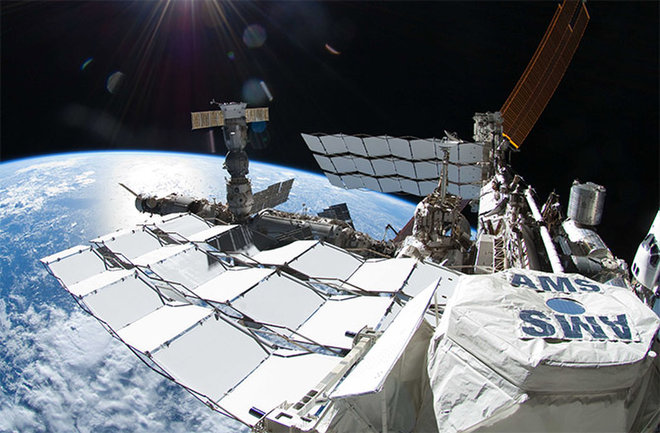Dark matter probe on space station to be revitalized
- NASA astronauts lose essential ISS fabric shield during spacewalk
- NASA captures vivid pictures of giant superstar cluster
Station commander Peggy Whitson and newly arrived rookie flight-engineer Jack Fischer, both with NASA, will kick off preliminary work on the $2 billion, 8.5-ton (77 metric tons) science instrument on a spacewalk tomorrow (May 12).
During their spacewalk, which is scheduled to last 6.5 hours, the astronauts plan to install a cable so engineers can test a data circuit in the AMS. The instrument was installed outside the station during the final flight of space shuttle Endeavour, in May 2011.
 |
|
The Alpha Magnetic Spectrometer has measured cosmic rays streaming toward Earth since 2011, searching for evidence of distant dark matter. Photo: NASA |
AMS is designed to study cosmic rays for signs of dark matter being annihilated in space.
Unlike regular matter, which emits or interacts with electromagnetic radiation, dark matter has never been observed directly. The existence of dark matter is inferred through its gravitational effects on visible matter. Current theories suggest dark matter may account for 85 percent of all the matter in the universe.
So far, AMS has tracked more than 100 billion cosmic ray hits in its detectors, AMS lead scientist Samuel Ting, a Nobel laureate with the Massachusetts Institute of Technology. AMS has also been measuring energy spectrums of helium, lithium, boron, carbon and other elements that fly toward Earth as cosmic rays. To keep AMS operational through the lifetime of the station, NASA plans to replace the device's cooling pumps next year, Ting said.
The pumps are part of a liquid carbon-dioxide cooling system that dissipates heat from the AMS as the station orbits in and out of sunlight.
The cable being installed during Friday's spacewalk will test a system that reads out engineering data from the device.
"We want to check if the readout system is still there. It's more or less an assurance check [to] make sure the communications will be there," Ting said.
Friday's spacewalk, which is scheduled to begin at 8 a.m. EDT (1200 GMT), will be the 200th devoted to station assembly and maintenance since construction of the outpost began in 1998.

